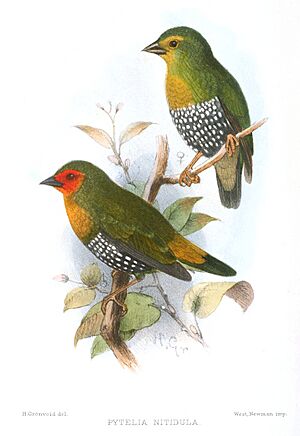Green-backed twinspot facts for kids
Quick facts for kids Green-backed twinspot |
|
|---|---|
 |
|
| Conservation status | |
| Scientific classification | |
| Genus: |
Mandingoa
|
| Species: |
nitidula
|
The green-backed twinspot (Mandingoa nitidula) is a small, colorful bird. It is also sometimes called the green twinspot. This bird is a type of estrildid finch. You can find these birds living in many parts of Sub-Saharan Africa. The IUCN (International Union for Conservation of Nature) says this species is of least concern. This means there are plenty of them, and they are not in danger of disappearing.
Contents
Different Kinds of Green-backed Twinspots
Just like people can have different looks depending on where they are from, animals can have different groups too. These groups are called subspecies. The green-backed twinspot has four main subspecies. They are all slightly different, but still the same main bird.
Here are the four subspecies:
- Mandingoa nitidula chubbi
- Mandingoa nitidula nitidula
- Mandingoa nitidula schlegeli
- Mandingoa nitidula virginiae
Where They Live and What They Look Like
Green-backed twinspots love to live in warm, wet forests. These forests are often found in tropical areas. You might also spot them in open grasslands or areas with lots of shrubs. They like places where they can find good cover and food.
It's easy to tell the boy twinspots from the girl twinspots! Male birds have bright red feathers on their faces. Female birds have an olive-green face. Their beaks are also darker, almost black.
Life and Reproduction

Green-backed twinspots like to have their own space, especially when they are ready to have babies. During the breeding season, the male bird tries to impress the female. He will raise his head and look straight up. Then, he does a special "dance" on a branch next to her. He moves sideways, like he's stepping. If the female likes his dance, she will crouch down. She will also point her tail towards him.
These birds usually stay with one partner. They work together to care for their young. After mating, the female lays up to four eggs. She usually lays one egg each day for about five days. The female bird will go in and out of the nest often. Once all the eggs are laid, she will sit on them. This helps the eggs stay warm until they hatch. This way, all the baby birds hatch around the same time.
Caring for Green-backed Twinspots
If people keep green-backed twinspots as pets, they need a special home. These birds enjoy a large bird enclosure, called an aviary. It should have many plants to give them privacy. This is especially important if they are going to breed. The temperature in their home should be warm. It should not go below 70°F (21°C) or above 84°F (29°C).
You can keep these birds in different ways. You can have a single pair, or even just one bird. In a very large aviary, you can keep up to four pairs together.
Green-backed twinspots eat different kinds of food. They enjoy millet, which is a type of grain. They also like dark leafy greens and fresh bananas. Cooked brown rice is another favorite. They also eat special mixed seeds made for finches.


